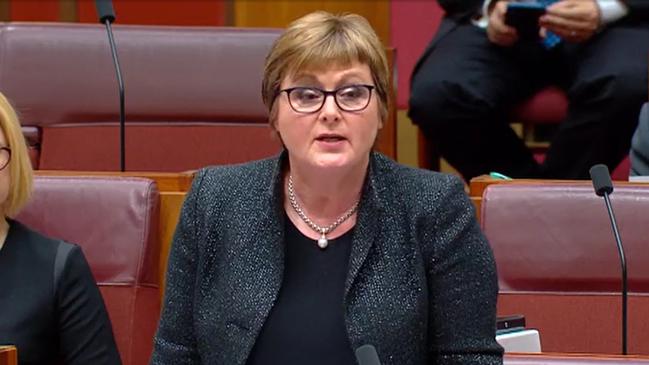
After years of research he put to the two public servants questions they had great difficulty in answering. There were long silences and sometimes, in desperation, they blamed instructions from Linda Reynolds for their inability to answer the questions.
While appearances before a Senate committee do not necessarily reflect the ability of public servants, this performance did not promote confidence in Australia’s defence preparations. Although Linda Reynolds did not appear before the committee, the role of the minister in the debacle did her no credit.
Senator Patrick has been engaged in a five-year research project to get to the bottom of what really happened in the massive submarine contract.
At the same time the Department of Defence, plus the current and previous defence ministers, have gone to extraordinary lengths to conceal the truth.
But they were caught out by the sheer tenacity of Rex Patrick, who plans to refer the failure of the Defence department to obey document demands from the Senate to the Senate privileges committee, which has the power deliver custodial sentences to offenders — an important power available when Senate orders are ignored or if the chamber has been misled. It is a power that has rarely been used.
The two ambushed public servants were the secretary of the Department of Defence Greg Moriarty, and Tony Dalton, who is responsible for Navy shipbuilding.
Patrick made it clear to the Senate committee that his aim was not simply to embarrass public servants or ministers but rather to get to the bottom of what was actually contained in the original French submarine tender and how that was changed into the agreement we now have.
Patrick believes but there was extensive Australian content involvement written in the original French proposal that was dropped in the final agreement.
What he has discovered, usually via Freedom of Information rights, is just how Defence concealed the information. And of course simmering in the back of everybody’s mind is the incredible statement made to the parliament by the Defence Minister Linda Reynolds that the original French proposal was that submarine would cost $50bn in 2016 dollars, when the then prime minister of Australia had told the cabinet that the cost in 2016 dollars was between $20bn and $25bn (he gave the actual figure).
Patrick has obtained Freedom of Information permission for that $20bn to $25bn figure in the original proposal to be released but, not surprisingly, Defence are appealing on the grounds of national security to prevent the Minister being caught out. Also, part of the Minister’s justification of the $50bn includes extras not part of original French tender price.

Some years ago Rex Patrick began his quest to find out what actually took place in the submarine affair by asking ministers for documents or information. And almost every time his requests were rejected on the grounds of national security. When documents were produced they had large areas blocked out — again on the basis of national security.
Most parliamentary backbenchers would give in at that point but Rex Patrick went to Freedom of Information to discover what Department of Defence regarded as jeopardising national security. Armed, he then waited for his opportunity — which came on the February 5 meeting of the Senate references committee.
With clinical precision, Patrick showed Greg Moriarty what Moriarty had actually declared as being a breach of the national security. Patrick went through each discovered document one by one. Not surprisingly, Moriarty was unable to explain why Defence criticism by the audit office over tender procedure was a national security threat; why a document stating that the Defence department wanted to maximise Australian content was a national security threat; why stating activities of a possible tenderer that were prominently displayed on its website was a threat to national security; and it went on and on.
The public servants said they would have more discussions with their Minister. I don’t propose to publish the transcripts but readers who want an hour’s gripping entertainment can click on this link to the parliamentary website, and go to the “Economics” session on February 5.
The simple situation is that the original French tender bore almost no relation to the final document. Either the French heavies had gone back on their word or our Defence department wanted an entirely different proposal. This is a very big issue for the nation and it’s tough on the original tenderers, who discovered that the tender that beat them had little relation to the final document.
And of course that roughly $23bn 2016 indicative price has absolutely no relationship to the total cost. While $23bn did not include the American combat system, infrastructure and matters of that sort, the cost is going way above $100bn. The submarines will not be ready to be delivered until around 2040, so we have almost 20 years of limited submarine defence.
Meanwhile the Defence tradition of rewriting history was underlined last week by Defence Minister Linda Reynolds when she said that the Joint Strike Fighter F-35 had come in on time and on budget. The original budget was a fraction of the current price and envisaged delivery 10 years ago. Since then there have been multiple budgets and time revisions and I guess the Minister is right that the current delivery and price is in line with the most recent budget.
I hope I am wrong but the bizarre events before the Senate committee, the claim that the JSF is on time and on budget, and the events inside the Minister’s office — plus the crazy costings on the submarine — are surface sign of something much bigger.





Defence Minister Linda Reynolds has an even bigger problem than the employee incidents in her offices. Two of Australia’s most senior defence public servants, appearing before a Senate committee, have been brilliantly ambushed by crossbench senator Rex Patrick.